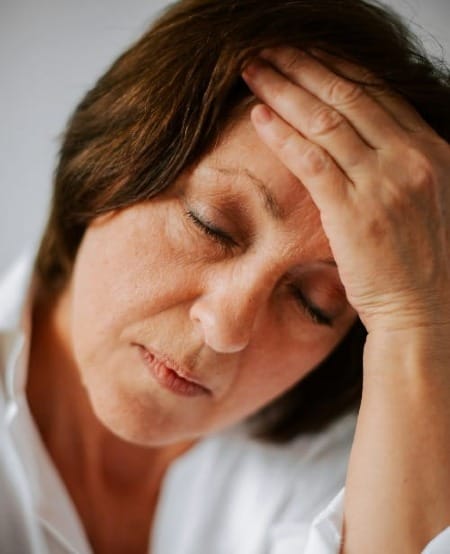Migraines in Midlife
I share my journey with hemiplegic migraines and hormones, from puberty to HRT, and invite women to share how migraines shape their midlife.

I’ve lived with migraines since puberty, the kind with multiple triggers, including shifts in estrogen. They’ve never been the “pounding head in a dark room” kind for me, but hemiplegic migraines, a rare type that can cause temporary numbness, vision changes, and even brief aphasia. They can feel a little like a stroke, but they pass. You can read more about hemiplegic migraines, how they’re diagnosed, and treatment options here.
For years, catching them early with aspirin and caffeine, or sometimes a stronger prescription like Maxalt (rizatriptan), was the best way to ride them out. Now in my late fifties, things have shifted. I don’t usually need Maxalt anymore, and Excedrin Migraine or even just aspirin and coffee can knock it back if I take them at the onset. Most of the time I don’t experience much pain, which I know is unusual. Only a few migraine episodes with nausea and pain showed up during perimenopause.
I want to be clear that medications that help me may not help everyone. I can’t use Imitrex (sumatriptan), which acts differently on blood vessels, so aspirin and caffeine, and Maxalt in the past, have been my personal tools for my specific type of migraines. Please check with your own doctor about what’s safe and effective for you if you are experiencing migraine headaches.
The very first time I tried an estrogen patch it triggered a migraine within about twelve hours. More recently, I noticed something else. A few hemiplegic episodes cropped up right after my insurance pharmacy switched the maker of my estrogen patches. The dose was supposedly the same, but my body seemed to notice a difference. Or maybe it was just the sudden weather shift and barometric pressure change. It’s hard to know, since I don’t keep a daily journal. That’s the thing with migraines. They keep us guessing, and for women especially, the connection with hormones only makes treatment more complicated. Too often it feels like migraines are lumped in with severe period pain, the kind women were expected to handle with a heating pad and a Tylenol.
What others are finding, too
Specialist clinics have long observed that migraine can flare in perimenopause. One survey at a menopause clinic found more than 40 percent of women reported migraines, and some experienced daily headaches that caused major disruption to their lives. Hot flashes, night sweats, anxiety, and disrupted sleep only add to the mix of triggers. Even after periods stop, fluctuating estrogen from the ovaries can continue for years, which means migraine doesn’t always settle right away. You can read more in this Migraine Trust article on perimenopause and migraine.
Some women do find relief through hormone therapy, but the key is using it in a way that avoids big hormonal swings. Patches, gels, or sprays that deliver estrogen steadily through the skin are often recommended. Progestogen is usually given continuously, since the sudden withdrawal of hormones is another known trigger. For women who can’t or don’t want to use hormones, low-dose medications like escitalopram or venlafaxine can help with both hot flashes and migraine. Lifestyle strategies like exercise, maintaining a healthy weight, and stress management are also shown to help.
Through almost every migraine, I worked. I literally stayed at work during my hemiplegic migraine episodes, recovering at my desk or in meetings, and kept going. I did this many times during my career. Early on, during my first freelance career, the one time I had to call in because I woke up with a migraine and couldn’t see to drive to a film location, I was fired and never hired by that production manager again. I am betting I am not the only one who has had to medicate and work through a debilitating medical condition just to keep their job. The point is, women’s health struggles are too often invisible or dismissed, yet the expectation is that we show up, smile, and perform as if nothing is wrong.
Looking back, especially at the onset of perimenopause, I realized that some of my migraines were paired with what felt like an anger panic attack, either right before or after. It was like a surge of rage boiling up from nowhere. I’ve since seen other women describe similar “rage attacks” in perimenopause, both on social media and even in the 2025 Oprah menopause special. Still, I have rarely seen this mentioned in the context of migraine. I can’t be the only one who has noticed a connection.
I want to ask you:
- Do you have migraines you believe are tied to changing hormones?
- If you are taking HRT, have you noticed any changes in your headaches?
- Have you ever experienced anger or panic tied to migraine episodes?
- What helps you, and what doesn’t?
I am opening this conversation because understanding what women endure, and how we cope, feels important. Sometimes the solutions are medical. Sometimes they are about lifestyle or self-knowledge. And often, they are about simply being heard.
Your story may be the missing piece for someone else. Would you be willing to share?
Add your experience in the comments below, or if you’d prefer to share privately, you can email me directly. I’d love to hear from you.
This is not medical advice, only my lived experience. Please consult your healthcare provider for guidance that fits your situation.


